If you have ever watched volleyball I’m sure there has been a stoppage and point awarded that has left you feeling somewhat confused.
As you turn to the referee to look for clarification you may just see a variety of hand signals which only adds to the confusion.
Unless you can watch with an informed commentator you may have to rely on your own deduction skills to work out exactly what is going on.
Fortunately the hand signals aren’t too hard to get to grips with and hopefully by the end of this article you will know exactly what each of them mean.
If you will look below you will see the full exhaustive list of all official hand signals.
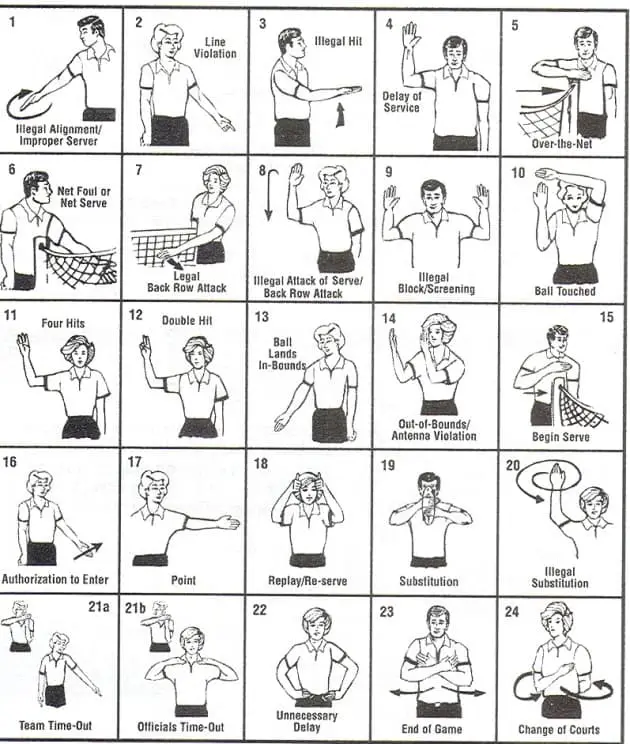
Now I appreciate some of the pictures may be a little confusing and on top of that if you don’t understand the terminology and small write up, you may still be unclear as to what has been decided.
So on that note let’s dive into more detail about exactly what call means and how the referee will show it.
Once you have the fundamentals worked out from reading the below, head over to Amazon by clicking here to get your volleyball essentials
Table of Contents
1. Illegal Alignment/ Improper Server
In Volleyball teams must start each rally in a specific rotation. This means players must stand in the correct order on court.
To learn more about rotations and in what order players should stand you can read my article here.
However in short once a point is won when the other team is serving you must rotate 1 position in a clockwise direction.
If a team is stood in the wrong location at the time the serve commences or the wrong person serves the ball, the other team will be awarded the point.

A referee would indicate this by straightening their arm at a 45 degree angle towards the floor on the side that is at fault. The referee would then make small circle motions to indicate that a rotation area has occurred.
2. Line Violation
When serving in volleyball it is illegal to step on or over the baseline during the serve.
The baseline are the two lines that form each end of the Volleyball court .
The officials that are normally in charge of the side and baselines are the line judges.
If a line judge or even referee spots a player stepping on or over the line when serving they would indicate this in the following way.

The official would point down at the offending line to indicate that a line violation has occurred.
3. Illegal Hit
Although volleyball looks rather simple and easy to pick up when you dive deep into the technique it can actually be very challenging.
With that in mind there are a lot of movements and motions that are considered illegal when playing the ball.
The most common forms are things such as lifts or carries.
A lift or carry is called if the ball comes to rest on a player for a prolonged period of time.
A carry would be called if the ball visibly changes motion or direction whilst still in control of a player.
A referee would should an illegal hit has occurred by doing the following.

The referee would place their forearm out in front of them with their palm facing upwards. The referee would then move their palm upwards to signify an illegal hit has occurred.
4. Delay of Service
Once the referee has blown the whistle to initiate the start of the rally, a player has 8 seconds to serve the ball.
If for whatever reason the player takes longer than the allocated 8 seconds, the referee will award the point to the other team for the delay in service.

A referee will show this has occurred by raising their hand with a flat open hand before awarding the point to the opposition team.
5. Over-the-Net
Now this rule is actually not as straightforward as it sounds and to the untrained or inexperienced player this is actually a very misleading rule.
In volleyball you are not allowed to reach over the net to attack the ball, however, there are actually quite a few exceptions to this rule.
You are allowed to reach over the net to play the ball if the opposition have you used their 3 allocated touches, hence why you are allowed to press a block over the net.
You can also reach over and attack the ball if the ball is travelling on to your side and there is no possibility of the opposition playing the ball again.

A referee would indicate that a hand over (or over-the-net) has occured by placing their arm over the top of the net when stood on the podium or steps.
If the referee is not stood on the referee stand they may use their other arm vertically to create a net whilst placing their other arm horizontally over the top to indicate the same thing.
6. Net Foul or Net Serve
This is certainly one of the more well known rules in volleyball however even this simple rule is sometimes misunderstood.
In volleyball you actually can touch the net providing it does not affect the rally or run of play.
With that being said there are very few situations in which someone touching the net wouldn’t affect the run of play.
Just to clarify a net violation includes the net and antenna.

If a net fault occurs the referee would take their hand on the side in which the net fault occurred and place their hand gently on the net to indicate the fault.
7. Legal Back Row Attack
Now I will be honest until I decided to put together this article I never knew this call even existed and to be honest I am still struggling to find a situation in which this would even be used?
In volleyball if a player is back row they are not allowed to attack the ball from in front the 3m (10 foot) line, unless they jump from behind the line.
Which brings me back to my previous point, if the attack is fine and legal then play would continue as planned until the point is won.
My best guess for this call is when further referee’s are involved in the game and they may instantly signal this if the attack is legal.
Much like how an official basketball signifies if the shot is taken behind the 3m line or how the officials throw the towel when a player enters the endzone in football.

Based on the picture attached above, an official would indicate a legal back row attack by placing their arm at shoulder height and waving it directly down whilst keeping the arm straightened.
8. Illegal Attack of Serve/ Back Row Attack
Now this call does makes a lot more sense to me.
In volleyball, especially at top level, a backrow is very viable option and is used an awful lot.
As I said above, in volleyball it is illegal for a back row player to attack the ball from on or in front of the 3m (10 Foot) line.
When focusing on the ball it is very difficult to judge exactly where the dividing line is and as such an illegal back row attack may occur.
It is also illegal to attack the ball from above the height of the net directly from a serve. This is to prevent people from jumping up and trying to block or spike the serve back.
Both of these faults would be shown the same way by the official.

The official would raise their forearm only keeping the upper arm horizontal at shoulder level.
From this position the official would rotate their arm at the elbow making a downward waving motion.
If you need a mental image think of the mechanically operated Maneki-neko or better known as the lucky chinese cat.
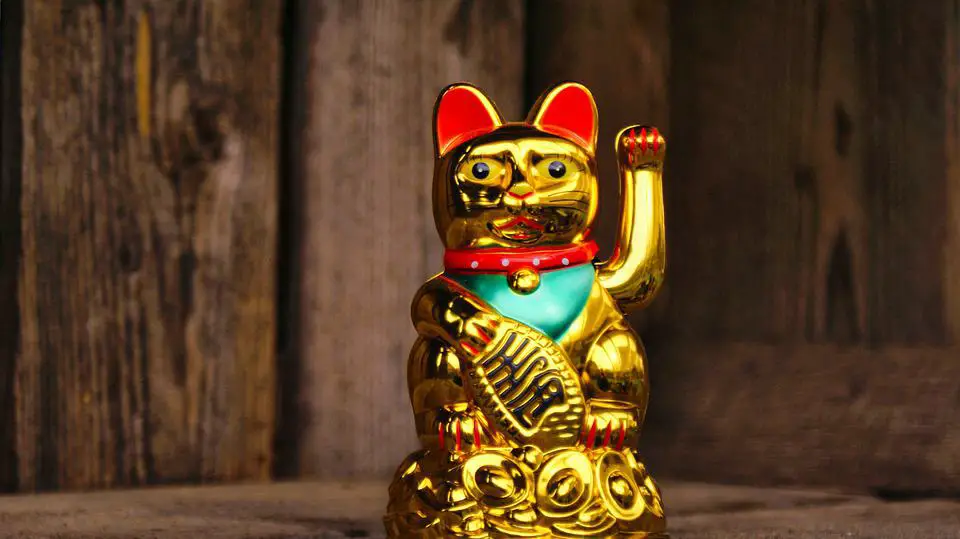
9. Illegal Blocking or Screening
Now this may come as a surprise to you as you will often see players from the serving team grouping at the net and raising their arms to restrict the receiving teams view.
However screening or blocking the line of sight is actually illegal in volleyball.
With that being said there is a rather loose interpretation of this rule.
What I mean by this is players are allowed to group together and raise their arms as long as the receiving team has a clear line of sight to the server and or service flight path.
This means as long as the serving team adopt normal base positions then a screen fault would not occur.
Now when I say normal base positions what I mean by this is, it is completely feasible that a player at the net would raise their arms in preparation for blocking, it is also conceivable that players would group together to make rotating to their correct position quicker and more streamlined.
So based on this you may be wondering when exactly an illegal block or screen call would occur.
Whilst it is allowed for players to group together and raise their arms, it is absolutely not allowed for players to move with the receiving players to ensure their sight remains obstructed, nor is it allowed for a player on the serving team to line up directly in front of the server to restrict the receiving players view.

If this was to happen the referee would indicate that an illegal screen has occurred by raising both hands upwards to head height forming and showing open palms towards the court.
10. Ball Touched
Everybody knows that if the ball lands out of bounds it is a point to the opposite team of the player who touched it last.
When a ball is hit by the attacking side it is quite common for the blockers or defenders to get a touch on the ball.
It is important for officials to notice this, as if the ball was to land out after a touch from the blockers or defenders, the attacking team would be awarded the point.
This is known as touch out or ball touched.

An official would indicate that the ball has been touched and gone out by placing one hand up and out in front of them, with their other hand they would brush their fingers upwards.
This shows the ball touching someone and then coming off them and out.
11. Four Hits
Each team is allowed 3 hits/ contacts from when the ball crosses the net to the point in which it must be returned back over the net.
The only exception to this rule is when a player blocks the ball, this does not count as a touch towards the team 3 touches, it also does not count as a touch for the individual player, this means a player can block the ball and then play it a second time without committing a fault.
There are many situations in which four hits may occur.
The most common one that springs to mind is sometimes when a player attacks the ball on a third hit, sometimes it actually bounces off the net band as opposed to being blocked.
If the team that just hit the ball touches it again after it comes off the net band this would be 4 touches.

This is actually one of the more obvious calls in volleyball in the sense that an official indicates this fault by simply holding up four fingers on one hand.
12. Double Hit
Although each team gets three contacts before the ball must be returned, with the exception of the blocking rule mentioned above, a player cannot contact the ball twice simultaneously.
What I mean by this is if a player receives the ball from the opposition, another player must touch the ball before the player that first received it can touch it again.
This rule is the bain of every setter to have ever played the game.
When hand setting it is very easy to double contact the ball.
If the ball doesn’t enter or leave the hands at the exact same time an official will often call a double contact.

A referee would indicate that a double touch has occurred by simply showing 2 up on one hand. Much like the hippie peace sign.
13. Ball Lands In
When the ball lands in a point is awarded to the team who was able to ground the ball on the oppositions side and between the lines.
Obviously an official needs a way of indicating whether the ball landed in or out of the court.
Especially in situations where it is tight to the line and could go either way.

An official would indicate that the ball landed in court by placing their arm at a 45 degree angle between the hip and shoulder and then pointing with their full arm and hand to the side in which the ball has landed in on.
14. Out of Bounds/ Antenna Violation
If the ball lands out of bounds or touches the aerial the opposing team would be awarded the point.
Just to clarify out of bounds encapsulates a few different things. The ball is considered out of bounds if it lands outside the court lines, contacts the net outside the antenna, the supporting or guide ropes of the net or the post and referee stand.

If the ball lands out of bounds or contacts the aerial the official would show this by bending both forearms upwards so the fingers are pointing towards the sky with their arms out in front of them.
15. Begin Serve
It is important that every player on the court understands when the serve is about to come.
In volleyball it is illegal to serve without the official signalling the start of the rally.

The first referee would signal the start of the rally and indeed the start of the serve by blowing the whistle and waving their hand from the servers side to the receiving teams side.
16. Authorization To Enter Court
If you don’t watch much high level/ professional volleyball or infact play a decent standard yourself you may not have ever seen this official hand signal.
After timeouts or even before new sets are about to start the teams must line up along the sideline where the referee stand is located.
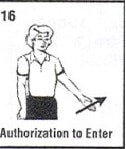
Once the officials and both teams are ready to commence play the referee will blow the whistle and wave their hand into towards the centre of the court.
This signifies to the players that they may enter the court.
I must admit I think this hand signal is somewhat fluid as I have personally seen officials wave my team and the other team into the court by using both hands.
17. Point Awarded
Now many of these hand signals show what fault has occurred, which to the players is often more than enough for them to determine who has won the point.
However in times in which the decision can go either way or infact just to make the decision clear to all spectators the official is able to show which side has been awarded the point.
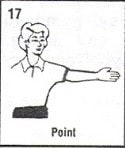
A referee would indicate which team has won the point simply by placing the arm of the side that has won the point out horizontally to point in the direction of the winning side.
18. Replay/ Let
This is certainly a signal that I feel is used a lot more at lower level volleyball.
A replay or let is shown for a few different reasons in Volleyball.
Where multiple games are being played at the time, occasionally balls or even players may enter a different court.
This not only causes a health and safety risk to the players on court but can also lead to obstruction or hindrance.
In these situations the fairest and safest option is to halt play and replay the point.
I have also seen lets used, when the decision is too tight to call.
For example if there has been a net touch but both players appear to touch the net at the same time, occasionally the official may choose to play a let or replay of point.
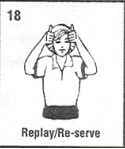
The referee would show a let or replay of the point by putting both thumbs up on either side of the net.
19. Substitution
Much like many other sports Volleyball uses substitutions.
Substitutions are used for many reasons, whether it be to replace an injured player, change up the lineup or simply just to swap in a service specialist to try and get a few aces.
If a team wants to sub in a player they must follow a simple process.
The player which is to be substituted in will be given the number of the player that they are to replace.
The coach will mention to the referee that they would like to substitute a player.
The player who is being subbed in will stand on the side of the court by the side of the referee and hold up a paddle with the number of the player they are replacing.
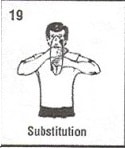
The referee will show that a substitution is taking place by placing their arms horizontally one over the other.
They will then rotate their arms in a spin cycle motion to signify that a swap or rotation in the line up has occurred.
20. Illegal Substitution
There are actually quite a few rules regarding substitutions.
Aside from the points I raised above about the process in which a substitution must be carried out there are also a few extras that bear mentioning.
For example if a player is substituted, if the coach wishes to substitute the previously swapped player back into the game, they can only do so if they sub them back in place of the player who previously replaced them.
For example if you want to substitute in a player to serve in place of a middle.
If you want the middle player to return to court when it is time for them to go front court, you would have to substitute out the player who first replaced them.
If the correct process is not followed, the player does not wait for the referee to confirm the substitution of a player replaces the wrong person an illegal substitution call would be shown.
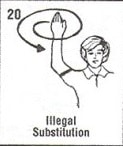
An official would show this by placing one arm up vertically above their head and then rotating it around.
21. Time-Out
In volleyball teams are allocated a certain number of time-outs per set. These timeouts can be used for a multitude of reasons.
Whether it’s discussing tactics with your team, give a motivational speech or simply just to break out the play.
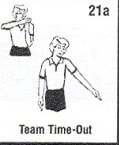
If a player or team requests a time-out the officials will signify this by creating a T using their hands.
This T will be displayed at head level to ensure all players can visibly see it.
After the T is displayed the official will point to the side which has called the timeout so it can be noted down on the score sheet.
22. Officials Time-Out
I will be honest in the years I have both been playing and spectating volleyball I have never seen this signal used.
Whilst I can see there might be a need for it, these situations are so few and far between that I have never seen it used.
The signal I am referring to is the officials time-out.
The main reasons in which I think this may be used would be if an official for whatever reason needed to be temporarily but immediately removed. For example a nosebleed or a sudden bowel movement.
The other example would be if there is some deliberation between decisions or repeat offenses that need clarification amongst the officials.
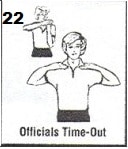
The way in which officials show this is again by creating a T with their hands that will be displayed at head level.
Once the T has been displayed the official turn their hands towards the head at shoulder level to indicate the timeout has been called by the officials and not either team.
23. Unnecessary Delay
This rule has actually undergone changes recently to reduce the severity of the penalty if this offense occurred.
An unnecessary delay is exactly what it says on the tin.
This is a delay to recommencing play that is deemed excessive or unnecessarily long.
These are often used when players are trying to slow down play either to disrupt the flow of the opponents or to try and regain energy after a long rally.
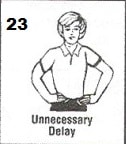
An official would show an unnecessary delay call by bringing the hands to the top of the waist, almost as if the official was going to rest their hands on their waist.
24. End of Game
Now this one really doesn’t need much explaining as it is very self explanatory.
This signal is used to indicate the end of the game.
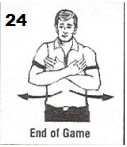
The end of the game is indicated by the 1st referee taking both arms and crossing them across the chest to form an X shape with the arms.
25. Change of Court Sides
In volleyball after each set the teams must switch sides.
After the referee has signalled the end of the set they will place one arm in front of them and the other arm behind them.
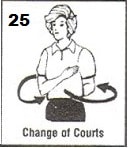
This indicates one team must rotate round to the other side of the court in front of the referee whilst the other team rotates behind the referee.
26. Set Point (Honorable Mention)
So one very common hand signal that isn’t displayed on the chart but is regularly used is the set point hand gesture.
When a team is on set point an official will clench a fist on the side of the team who has set point and hold it directly up in the air.
This indicates to all players, officials and spectators that a team has set point.
